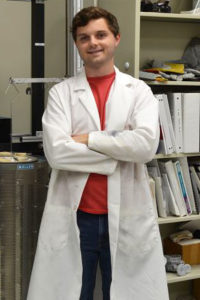
Cordell Delzer
Recent doctoral graduate Cordell Delzer (MS/MSE ’19; PhD/NE ’20), who was a Nuclear Science and Security Consortium (NSSC) fellow for all five years of grad school, was recognized by the NSSC with the Outstanding Thesis for Radiation Detection. His thesis, entitled, “Fabrication of Specialized Scintillators for Nuclear Security Applications” focuses mainly on the development of two types of detectors.
“I am thankful for the recognition of my work because, it shows the people who helped me along the way that I was able to be productive with the resources they gave me,” said Delzer.
At UT, Delzer worked with both the Scintillation Materials Research group led by Associate Professor Mariya Zhuravleva and Research Professor Charles Melcher, as well as the Rad IDEAS group led by Professor Jason Hayward. His research brought together the expertise of these two groups to allow for research of radiation detectors that spans from material discovery to characterization in environments similar to those seen in the field.
One of his projects focused on development of Cesium Hafnium Chloride as a scintillator for use in handheld detectors systems, while another focused on developing a new alpha detector for use in associated particle imaging (API) systems. API systems under development use neutrons produced by fusion along with multi-modal imaging technology to make very detailed images of containers that may be concealing illicit nuclear materials, allowing them to be found and identified quickly and accurately.
“He was mentored by many as part of his work, besides me, and learned so well from all,” said Hayward, who was the Major Professor for his PhD work. “The breadth and quality of the work is really amazing.”
At national laboratories, Delzer worked especially closely with researchers Stephen Payne at Lawrence Livermore National Laboratory and Joshua Cates at Lawrence Berkeley National Laboratory.
“Dr. Payne played a huge part in teaching me how scintillation materials work on a very fundamental level and Dr. Cates taught me about scintillator timing resolution,” said Delzer. “This included taking time to teach me how to build my own experimental setup from the ground up all while communicating virtually. I enjoy learning new things, so I was lucky to find a project with such breadth as well as the opportunity to learn from such great mentors.”
Delzer is now working with Los Alamos National Laboratory, developing new radiation detection materials.